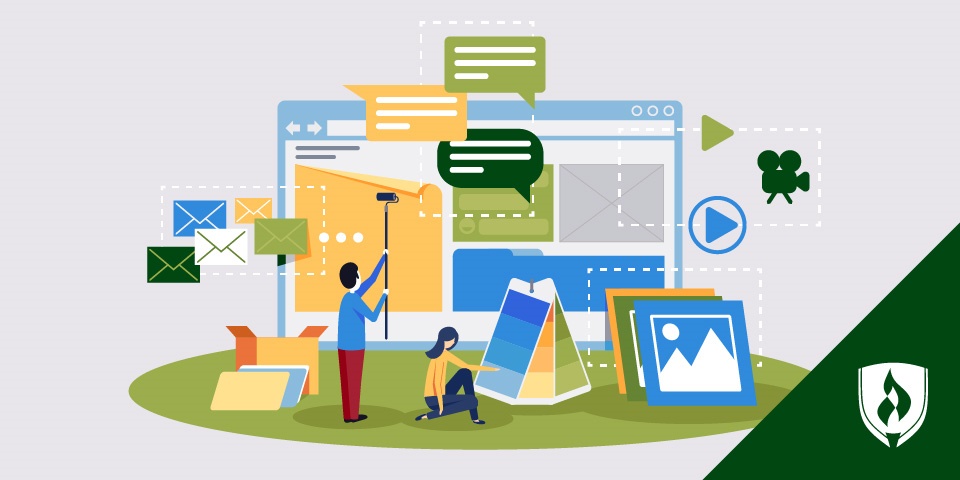Get Competitive: 7 Tech Skills & Certifications for Graphic Designers
By Brianna Flavin on 03/14/2018

You love good design. Far beyond sleek, minimalistic packaging or a trendy logo—you see great design as effortless functionality. Impressive face value is great, but if users can’t easily use the product, then the design is just decoration. The industry of graphic design has plenty of professionals who can make something look good, but the designers who care about the clients as much as their own aesthetic will always stand out.
So how can you show to employers and clients that you’re willing to go the extra mile? One of the best options is to have a diverse array of skills to bring to the table. A well-rounded skill set will help you set yourself apart from a competitive crowd.
We asked graphic designers and the professionals who hire them which skills and certifications for graphic designers will make the biggest impact. Read on to get a few ideas on making yourself more marketable in the field.
7 Tech skills and certifications for graphic designers
1. Coding
“Knowing how to code will instantly make a graphic designer more competitive,” says Meagan Michal, senior marketing manager at Tech Talent South. “It makes sense when you think of how much of a designer’s work must exist within an environment that was built with code. Finding a good designer who also understands the language of these environments is crucial.”
Certification exists in many different coding languages as well as for different platforms. JavaScript, HTML, Python and CSS are all good choices to try your hand at coding, and many of these offer certification exams.
2. Adobe® Creative Suite®
An expert knowledge of Adobe® Creative Suite® is an important skill, even an expectation for graphic designers, according to Larissa Montecuollo, creative director of Trillion. But beyond a strong portfolio, it’s not always easy to show your proficiency. To help with that, Adobe® offers certifications to allow you to showcase your competency with their products on a resume.
3. Animation
“I would love to learn animation,” Montecuollo says. “I think graphic designers who have this skill are extremely marketable right now and have the ability to create beautiful interactive designs for web and social media.”
Looking ahead as well, Michal says digital design will become increasingly more movement-based. “We will need to know how to create designs that move and sometimes even respond to user activity.”
Animation is too large a skill to be covered well by a certification program, but earning an Associate’s degree with a focus in Animation and Motion Graphics can be a great way to learn and highlight animation skills.
4. Search Engine Optimization (SEO)
“These days graphic designers are going to be working somewhere in the marketing industry,” says Drew Kalinski, e-commerce manager at Ayer Comfort. “With the rise of SEO—content is king, and graphic designers are going to need to understand this to create content that will be shared and reused around the web. So SEO is going to be an important skill set to learn and bring more value to the designer.”
Unfortunately, there isn’t a clear industry standard for SEO certifications. That said, you can’t go wrong supplementing your SEO knowledge with information from sources like Moz or HubSpot. Additionally, it might be worth your time to pursue a Google AdWords certification—this plus a graphic design education make an excellent foundation for any designer planning to work on digital marketing campaigns.
5. Mobile development
“I think any designer that can add the fundamentals of web or mobile development will enhance their resume,” says Tim Keough, CEO of Sympli. Since many graphic designers will wind up working on projects that demand mobile accessibility, a better understanding of mobile development can be a big selling point. This doesn’t mean you have to be able to write a functioning app from scratch, but knowing enough about how they’re created and the basics of common mobile development languages like Swift, Objective C and Java can go a long way toward your marketability.
6. Copywriting
“Copywriting and graphic design tend to go hand in hand,” says Liam Pedley, owner of Liam Pedley Design. “It’s important to practice both. You are more desirable for roles that are bit more multifaceted in this case and can utilize these skills elsewhere, too.”
This skill can be particularly useful for freelance designers—copywriting skill plus design abilities means you can take on a larger percentage of the work for any design project. Additionally, even if you know copywriting isn’t your strong suit, understanding the mentality and processes of a copywriter can help you become a better collaborator. Text and visuals are codependent, so having a better understanding of how to properly balance their relationship within a design—and the limitations to each—is important.
7. Communication and collaboration
These aren’t specific certifications. But they are worth mentioning since nearly every expert we heard from named communication and collaboration skills as the most important assets a graphic designer can have. Design is not an isolated art, and many employers are looking for collaborators who can design while also being a team player with the rest of the company.
“I think more and more employers are looking for designers that have experience with (and a willingness to use) more concrete tools and processes that help teams deliver more rapidly, reduce cycle times, better track assets and designs and integrate well into other projects,” Keough says. Keough uses examples like design file version control, integration with other project management and workflow tools like Atlassian Jira and compliance with security processes.
“Experience with more formal processes and best practices further enables designers to deliver value to employers and further differentiate themselves.”
Getting competitive
Graphic design isn’t the only field where some extra areas of specialization and skill can make a huge career difference—but many of the above skill sets are less common in graphic design. Whether you are looking for new clients or hunting for an employer, having verified skills on your resume can give you the competitive advantage you need.
But even highly qualified candidates can lose opportunities over silly mistakes. When all you have is a few seconds on a piece of paper, you’ve got to make that impression count. Check out our article, “Do’s & Don’ts of Graphic Design Resumes: Tips for Rookies” for more advice on how to fine-tune your presentation.
Adobe® Creative Suite® is a registered trademark of Adobe Systems Incorporated.
Related Articles:
- 16 Tips to Help Promote Your Creative Thinking
- How to Work with Layers in Photoshop
- Typeface vs. Font and 11 Other Typography Terms Designers Need to Know
- How to Find a Graphic Design Job: Advice from the Experts
- 6 Compelling Reasons Why Graphic Design Internships are Important
- Art vs. Design: Determining the Degree for Your Creative Career




